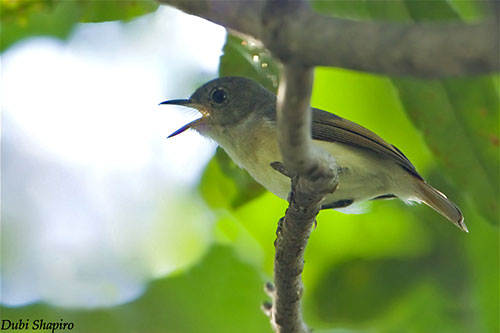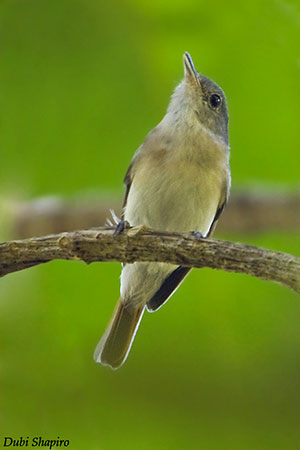
REPRODUCTION OF THIS SPECIES:
There is no information. However, we can suggest that this behaviour is fairly similar to that of the other species of genus Newtonia. The nest is a deep cup built among the vegetation, probably in tree at variable height, or often close to the ground.
In these species, the female often lays three eggs, but the size of the clutch probably varies. More information is required.
PROTECTION / THREATS / STATUS:
The Red-tailed Newtonia is threatened by habitat loss through slash-and-burn cultivation involving degradation of regrowth and destruction of grassland. The range of this species includes highly degraded forest, and the increasing human population is another important threat.
The population is roughly estimated to number 3,500/15,000 individuals, and is suspected to be declining.
The Red-tailed Newtonia is currently listed as Vulnerable.
Fr: Newtonie de Fanovana
Ang: Red-tailed Newtonia
All: Fanovananewtonie
Esp: Newtonia Colirroja
Ita: Newtonia codarossa
Nd: Fanovananewtonia
Sd: roststjärtad newtonia
Photographer:
Dubi Shapiro
Dubi Shapiro Photo Galleries & Dubi Shapiro's Pictures on IBC
Text by Nicole Bouglouan
Sources:
HANDBOOK OF THE BIRDS OF THE WORLD Vol 11 by Josep del Hoyo, Andrew Elliott and David Christie - Lynx Edicions - ISBN: 849655306X
Birds of Madagascar and the Indian Ocean Islands Par Roger Safford, Adrian Skerrett, Frank Hawkins – ISBN: 1472924118, 9781472924117- Editeur: Bloomsbury Publishing, 2015
The Birds of Africa: Volume VIII: The Malagasy Region: Madagascar, Seychelles, Comoros, Mascarenes - Par Roger Safford, Frank Hawkins – ISBN: 1408190494, 9781408190494- Editeur: A&C Black, 2013
Birds of the Indian Ocean Islands Par Ian Sinclair, Olivier Langrand - ISBN: 1868729567, 9781868729562- Editeur: Struik, 2003
Birds of Madagascar: A Photographic Guide Par Pete Morris, Frank Hawkins – ISBN: 0300077556, 9780300077551- Editeur: Yale University Press, 1998
Wildlife of Madagascar par Ken Behrens,Keith Barnes - ISBN: 140088067X, 9781400880676 – Editeur: Princeton University Press, 2016
Creagus – Bird Families of the World – Vangas - Vanginae
THE VANGAS OF MADAGASCAR by Nick Garbutt
Vanga - From Wikipedia, the free encyclopedia
Home page
Page Order Passeriformes
Red-tailed Newtonia
Newtonia fanovanae
Passeriformes Order – Vangidae Family
INTRODUCTION:
The Red-tailed Newtonia is endemic to Madagascar. This species was formerly classified in the subfamily Phylloscopinae within the Sylviidae, the Old World Warbler’s family. It is now included in the family Vangidae, with three other species of genus Newtonia.
This species is found in the eastern rainforest, usually below 1,000 metres of elevation. It occurs only in large tracts of intact forest where it hunts from perches while searching for flying insects.
The Red-tailed Newtonia is threatened by habitat loss through forest destruction. It is currently listed as Vulnerable.
DESCRIPTION OF THE BIRD:
Biometrics:
Length: 12 cm
Weight: 12-13 cm
The Red-tailed Newtonia has greyish-brown mantle, scapulars, rump and upperwings where the primaries are slightly darker. We can see a paler panel formed by the pale rusty edges of the secondaries. The uppertail-coverts are pale tawny-rufous, whereas the rectrices are rufous-brown with dull brown inner borders and tips.
The underparts are white, but breast sides and flanks are variably washed cinnamon-buff.
The head is ashy-grey on top and sides and contrasts with the white chin and throat.
The slim bill is blackish or dark horn on upper mandible, and mostly paler grey on lower mandible. The eyes are reddish-brown to dark brown. Legs and feet are blackish.
Male and female are similar. The juvenile is not currently described.

RANGE:
The Red-tailed Newtonia is found in E Madagascar from Marojejy in the N, to Andohahela in the S.
HABITAT:
The Red-tailed Newtonia is confined to undisturbed lowland rainforest where it forages in middle and upper levels of tall trees. This species occurs between 300 and 800 metres of elevation, rarely higher.
CALLS AND SONGS: SONS PAR XENO-CANTO
The song of the Red-tailed Newtonia is a medium to high-pitched series of descending whistles “whit-whit-whit-whit-whit-whit” that often alternates with other series of double notes “whit’se-whit’se-whit’se…”
These songs are often given in turn by the same bird. The call is not described.
BEHAVIOUR IN THE WILD:
The Red-tailed Newtonia feeds on various insects including crickets. It forages high in the canopy by sally-gleaning and hovering at the ends of the branches. It usually feeds in mixed-species flocks, and especially with the Common Newtonia and jeries of genus Neomixis. But it also forages in mid-storey and can be seen flitting through the foliage while its rufous tail is slightly open.
By night, the Red-tailed Newtonia roosts perched on bare branches close to the ground.
There is no information on breeding and nesting behaviour.
This species is apparently sedentary on the island. Its short, rounded wings do not allow long-distance flights.
